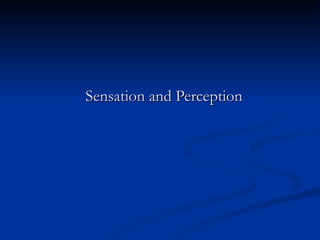
Modules 14 and 15 PowerPoint Slides
- 2. Sensation • Process by which body gathers information about environment • Connects us to the world • Sensation generally occurs in the sense organs – vision (detects light waves) – olifaction (sense of smell) – gustation (sense of taste)
- 3. Perception • Process by which the brain organizes and interprets sensory information (“sensation PLUS perception”) • Perception occurs in the brain • 3 basic principles o adaptive o active o no one-on-one correspondence between physical and psychological reality
- 8. Perception • Top-down processing o “Conceptually-driven processing” o Take information already existing in the mind to interpret environment • Bottom-up processing o “Data-driven processing” o Take stimuli from the environment and make attempts to determine its meaning
- 9. Sensation • Sensory receptors – Eyes, ears, nose, etc. detect physical energy (light/sound/smell) • Transduction – Translates physical energy into neural signals • Absolute threshold – Each system’s minimal amount of energy required to activate it • Difference threshold – Each system’s minimal amount of energy required to detect change from one level of stimulus to another – Just-noticeable difference (Weber’s Law)
- 10. Stroop Effect • In this experiment, say the color of the word (not what the word says) • Example: For the word RED you should say “Red”. For the word RED you should say “Yellow“ • As soon as the words appear on your screen, read the list as fast as you can
- 13. Stroop Effect • In this experiment, look at a picture of an animal and say the name of the animal. Do NOT read the word placed on the picture. • For example: You should say "Cow" because the animal in the picture is a cow. • You should sat “Cat” because the animal in the picture is a cat.
- 16. Vision • Allows for the detection of movement, light, depth perception • Transduction – impulses from optic nerve carry visual information from retina to optic chiasm; neural messages then travel to thalamus and into the visual cortex
- 17. Vision • Motion perception o Rods in retina sensitive to motion activate neurons in the visual cortex o 2 systems for processing movement - Eye stationary as object moves - Eye moves to maintain object at same place on the retina
- 20. Vision • Photoreceptors o Cones - Highest concentration in the fovea - Require light to be activated - Color vision/trichromatic theory (“photopic vision”) - High visual acuity o Rods - Highest concentration in the retina - Night vision (“scoptic vision”) - Low visual acuity - High sensitivity (esp. motion detection)
- 24. Vision • Color blindness • Inability to distinguish colors • “Disease” is linked to the X chromosome, thus males more likely than females to be color blind • Most common condition is red-green color blindness (difficulty distinguishing red and green)
- 28. Hearing • Transduction o Outer ear collects physical stimuli (sound waves) o Inner ear carries movements via waves of fluid (in ear drum) that generate neural signals o Signals sent to thalamus then to temporal lobe
- 30. Hearing • Volume – “loudness” determined by the height of sound wave (amplitude) • Pitch – refers to the frequency of the sound wave (low B flat/high C tone)
- 31. Touch • Protects body from injury, helps identify objects, maintain body temperature • 4 basic skin sensors (heat, cold, pain, pressure) • Touch sensations differ throughout the body • Transduction o Sensory neurons in skin send impulses to spinal cord or communicate with interneurons (that in turn stimulate motor neurons)
- 33. Taste • Refers to four basic tastes (sweet, sour, salty, bitter) and protects us from injecting toxic substances • Transduction o Occurs in the taste buds o Physical stimulus (soluble chemicals) activate taste receptor neurons which carry information to thalamus and primary cortex to help identify taste
- 34. Smell • Detect danger (e.g., smoke, spoiled food) and/or recognize familiar odors • Transduction o Physical stimulus (air molecules) enter nasal cavity through nose o Receptors in olfactory epithelium pass information through the olfactory bulb to the primary cortex